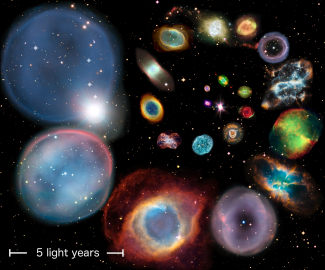Media
HKU astronomers develop a new method to estimate more accurate distances between planetary nebulae and the Earth
26 Nov 2015
With the new method to estimate more accurate distances between planetary nebulae and the Earth developed by Dr David Frew (right), Professor Quentin Parker (left) and Dr Ivan Bojicic, the ghostly and beautiful planetary nebulae finally get more meaningful physical presence.
A way of estimating more accurate distances to the thousands of so-called “planetary nebulae” dispersed across our Galaxy has just been announced by a team of three astronomers based at the University of Hong Kong (HKU). Dr David Frew, Professor Quentin Parker and Dr Ivan Bojicic, based on a culmination of ten years of research work, developed a new method for measuring more accurate distances between “planetary nebulae” and the Earth. With this technique, “planetary nebulae” finally get a more meaningful physical presence. The scientists have published their results in the Monthly Notices of the Royal Astronomical Society on November 18.
Ghostly and beautiful planetary nebulae” have nothing to do with planets but acquired this name because these glowing spheres of ionized gas resembled planets to early observers. They are the colourful, ejected shrouds of dying stars, which offer a brief window into the history of many stars’ lives, including that of our Sun. Their stunning shapes make them popular with the wider public, but a full exploitation of their scientific potential has been blunted by poor distance determinations for them.
The solution, presented by these authors, is both simple and elegant. More accurate distances between the most common type of “planetary nebulae” and the Earth can be estimated simply with three sets of data: firstly, the size of the object on the sky taken from the latest high resolution surveys; secondly, an accurate measurement of how bright the object is in the red hydrogen-alpha emission line; and thirdly, an estimate of the dimming toward the nebula caused by so called interstellar-reddening. The resulting so-called “surface brightness - radius relation’ has been robustly calibrated using more than 300 planetary nebulae whose accurate distances have been determined via independent and reliable means (e.g. trigonometric parallax measurements of their central stars).
The first author of this research Dr David Frew, Research Assistant Professor, Department of Physics said: ‘measuring distances to Galactic “planetary nebulae” has been an intractable problem for many decades, because of the extremely diverse nature of both the nebulae themselves and their central stars. However, understanding their true nature and physical characteristics depends crucially on knowing their distance. With our significantly improved distance estimates we can finally provide more meaningful values for many key parameters of scientific interest.’
The second author of this research Professor Parker, who is also the Head of the Physics Department in HKU, explained: ‘the basic technique is not new but what marks out this work from what has gone before is the use of the most up-to-date and reliable measurements of all of those crucial properties’. This is combined with the use of the authors’ own robust techniques to effectively remove “doppelgangers” and mimics that have seriously contaminated previous planetary nebulae catalogues, which added considerable scatter to previous statistical distance scales.
Incredibly, the new distance scale works over a factor of more than six powers of ten in surface brightness. The technique can provide distances accurate to 20 percent, which a major advance on previous estimators that can have errors of a factor of two or more. “In the past, the old distance scales worked fairly well for small planetary nebulae but got systematically worse for the larger nebulae. Ours is the first scale to be able to estimate distances for all planetary nebulae. As big planetary nebulae are the most common, we will use our new scale in making an unbiased census of planetary nebulae in the Milky Way, which will then help answer some important research questions.” Dr Frew added.
This latest research by HKU astronomers promises a new era in our ability to study and understand this fascinating if brief period in the final stages of the lives of low- and mid-mass stars.
Further information
The new work appears in the latest “Monthly Notices of the Royal Astronomical Society”, Oxford University Press. For details, please visit http://mnras.oxfordjournals.org/lookup/doi/10.1093/mnras/stv1516
For the powerpoint presentation, please click here.
Science contacts
Dr. David Frew, Department of Physics, The University of Hong Kong (Mobile: +852 9415 2556; e-mail: djfrew@hku.hk)
Prof. Quentin Parker, Department of Physics, The University of Hong Kong (Mobile: +852 5669 9166; e-mail: quentinp@hku.hk)
Dr Ivan Bojicic, Department of Physics, The University of Hong Kong (Mobile: +852 6682 7976; email: ibojicic@hku.hk)
Media contacts
The University of Hong Kong:
Ms Rhea Leung, Communication and Public Affairs Office (Tel: +852 2857 8555/ +852 9022 7446; email: rhea.leung@hku.hk)
Ms Cindy Chan, Faculty of Science (Tel: +852 3917 5286/ +852 6703 0212; email: cindycst@hku.hk)
Dr Robert Massey (Tel: +44 (0)20 7734 3307 / rm@ras.org.uk)
Dr Sam Lindsay (Tel: +44 (0)20 7734 3307/ sl@ras.org.uk)
Dr Morgan Hollis (Tel: +44 (0)20 7734 3307/ mh@ras.org.uk)
A collage showing 22 individual planetary nebulae all at various distances from Earth. They are artistically arranged in approximate order of physical size. The scale bar represents 5 light years. Each nebula’s size is calculated from the authors’ new distance scale, which is applicable to nebulae of all shapes, sizes and brightnesses. Credit: ESA/Hubble & NASA. Compiled by HKU Physics.
The physical sizes of two of the largest planetary nebulae, presented at a common scale based on the authors’ new distances. The scale bar represents 5 light years. Older distance scales underestimated the distances and hence sizes of these very old nebulae. Credit: NOAO/AURA/NSF. Compiled by HKU Physics.
Based on a culmination of ten years of research work, the new method to estimate more accurate distances between planetary nebulae and the Earth developed by HKU astronomers promises a new era in scientists' ability to study and understand the fascinating if brief period in the final stages of the lives of low- and mid-mass stars.


